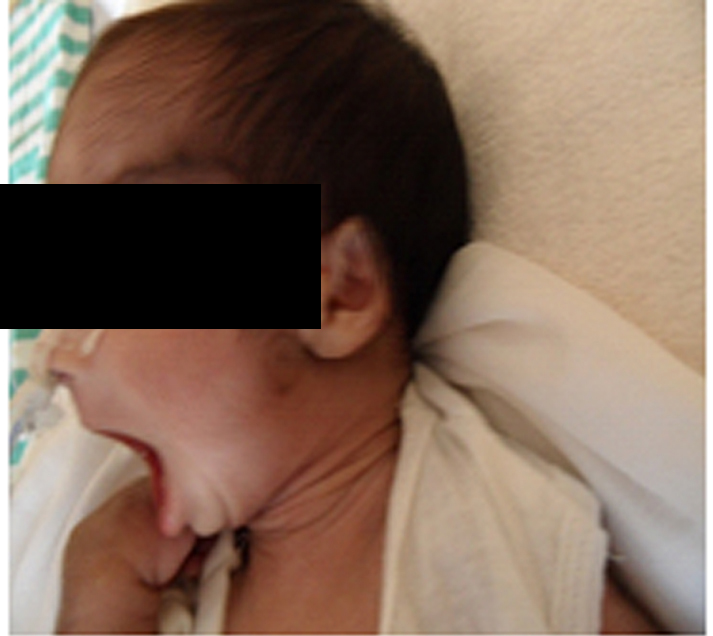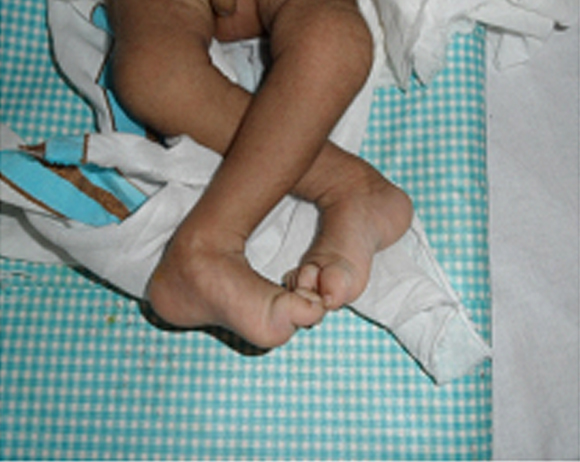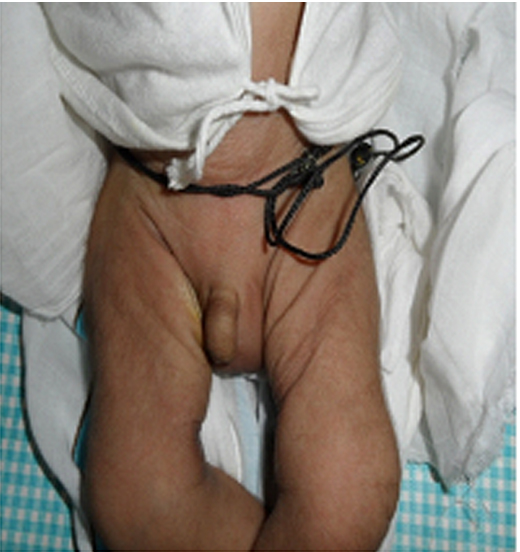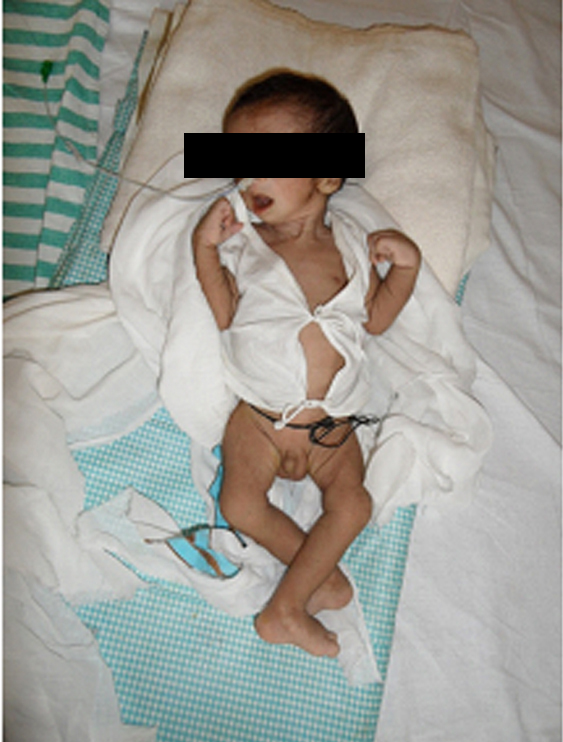A Rare Case of the Lenz Syndrome
Sohil T1, Ketki K2, Rukmini M S3, Nutan K4, Poornima M5
1 Post Graduates, Department of Biochemistry,
2 Post Graduates, Department of Biochemistry,
3 Associate Professor, Department of Biochemistry,
4 Professor and Head, Department of Paediatrics,
5 Professor and Head, Department of Biochemistry, Kasturba Medical College, Mangalore, Manipal University, India.
NAME, ADDRESS, E-MAIL ID OF THE CORRESPONDING AUTHOR: Dr. Sohil T, Post Graduates, Department of Biochemistry, Kasturba Medical College, Mangalore, Manipal University, India.
Phone: 7829723132
E-mail: sohilcusmc@gmail.com
We are reporting here, a case of the Lenz syndrome in a neonate who was brought to the Paediatric OPD, Kasturba Medical College Hospital, Attavar, Mangalore India, with the complaints of poor suckling since birth and abnormal facial features. Altogether, the characteristic congenital abnormal findings in Lenz syndrome, which comprise of microophthalmia, ear anomalies, microcephaly, skeletal and digital deformities, and urogenital malformations were observed, with an exception of a dental anomaly. Dental abnormalities were not pertinent, as the patient was a neonate.
Lenz syndrome,Microophthalmia,Microcornea
INTRODUCTION
The Lenz syndrome is a very rare, X-linked, recessive, inherited condition, which occurs exclusively in males. Having been described by Lenz in 1955, the characteristics of the syndrome are, abnormal development of the eyes, with malformation of the ears, teeth, fingers, skeleton and the genitourinary system.
CASE
A 24 days old male infant was brought to the Paediatric OPD, Kasturba Medical College Hospital, Attavar, Mangalore, India with the complaints of poor suckling since birth and abnormal facial features. This full term, vaginally delivered baby weighed 2.11kg with a length of 43cm and a 32.5cm head circumference on admission.
The physical examination findings: a hairy forehead, bilateral pre auricular tags, micrognathia, a high arched palate, a valgus deformity on the left foot, bilateral clinodactyly and bilateral claw hand deformity.
The ophthalmological examination findings: Bilateral micro ophthalmia, left eye corneal opacity Biochemical investigations: Sodium-161mEq/L,Potassium- 3.6mEq/L,Calcium-9.7mg/dl, Creatinine- 0.7mg/dl, SGPT- 45 IU/L, Urea- 46mg/dl and C-reactive protein- 5mg/dl Karyotyping revealed no chromosomal abnormality. Ultrasonography: Pelvic-ureteric junction obstruction and a dynamic dislocation of the hip. Based on these findings and the facial features, a clinical diagnosis of the Lenz syndrome was made [Table/Fig-1,2,3,4 & 5].


Microophthalamia and left eye corneal opacity

Dynamic dislocation of hip


DISCUSSION
The Lenz syndrome is a very rare, X-linked, recessive, inherited condition with a male predominance [1]. Mutations in at least two genes of the X chromosome are thought to be responsible for this condition. Only one of these, the BCOR gene, has been identified.
The BCOR gene provides instructions for the protein which is called the BCL-6 co-repressor, which plays an important role in the early embryonic development. A mutation in the BCOR gene disrupts the normal development of the eyes, several other organs and tissues before birth. Researchers are working to determine whether the Lenz syndrome is a single disorder with different genetic causes or two very similar disorders, each of which are caused by mutations in different genes. Apart from the BCOR gene which is on the MAA2( Microophthalmia with associated anomalies) locus on the X chromosome, another additional locus, that is MAA, which is also on the X chromosome, has been suspected. A missense mutation, nt 254 C>T; P85L on the MAA2 locus which is situated at Xp11.4-p21.2, has been found in affected males. At the MAA locus which is situated at Xq27-q28, the mutation remains elusive [2,3].
The Lenz syndrome is inherited in an X-linked, recessive manner. If the mother is a carrier, the chances of transmitting the mutation is 50% in each pregnancy. Males who have inherited the mutation will be affected and females who have inherited it will be carriers [1].
The clinical manifestation of the Lenz syndrome includes mainly eye features like unilateral or bilateral microophthalamia, which are often accompanied by microcornea and glaucoma. In other abnormalities, the ears may be low set, cup shaped or abnormally moulded. The dental findings include irregular or missing teeth. Skeletal abnormalities like duplicated thumbs, clinodactyly, syndactyly and microcephaly are common. Approximately 60% of the affected males have mild to severe intellectual disability or a developmental delay [4]. Hypernatraemia is one of the biochemical findings in this case. It has been seen in low birth weight children, which is caused by free water deficits [5].
The patients have to be managed in accordance with the congenital anomalies which are present, as no specific management is available [7] [Table/Fig-6].
The findings in patient and characteristic major abnormalities (% ) in Lenz syndrome [6].
| Abnormalities | Percentage of Features Found | Females (n=32) |
|---|
| Microophthalmia | 100 | + |
| Ear abnormalities | 63 | + |
| Microcephaly | 83 | + |
| Skeletal abnormalities | 67 | + |
| Dental abnormalities* | 48 | – |
| Digital abnormalities | 44 | + |
| Urogenital abnormalities | 77 | + |
| Palate abnormalities | 33 | + |
| Retardation* | 63 | – |
CONCLUSION
The Lenz syndrome requires a symptomatic management by multiple specialities which work in tandem, in accordance with the congenital anomalies which are present in the individual patient.Genetic counselling plays an important role in the subsequent pregnancy.
[1]. Forrester S, Kovach MJ, Reynolds NM, Urban R, Kimonis V, Manifestations in four males with and an obligate carrier of the Lenz microphthalmia syndrome Am J Med Genet. 2001 98:92-100. [Google Scholar]
[2]. Hilton E, Johnston J, Whalen S, Okamoto N, Hatsukawa Y, Nishio BCOR analysis in patients with OFCD and Lenz microphthalmia syndromes, mental retardation with ocular anomalies, and cardiac laterality defects Eur J Hum Genet. 2009 17:1325-35. [Google Scholar]
[3]. Ng D, Thakker N, Corcoran CM, Oculofaciocardiodental and Lenz microphthalmia syndromes result from distinct classes of mutations in BCOR Nat Genet. 2004 36:411-16. [Google Scholar]
[4]. Ng D, Hadley DW, Tifft CJ, Biesecker LG, Genetic heterogeneity of syndromic X-linked recessive microphthalmia-anophthalmia: is Lenz microphthalmia a single disorder Am J Med Genet. 2002 110:308-14. [Google Scholar]
[5]. Doherty E, Fluid and Electrolyte Managemant. In: Cloherty J, Eichenwald E, Hansen A, Stark A, editors Manual of Neonatal Care 2012 7thUSAWilliams and Wilkins:269-83. [Google Scholar]
[6]. Ozkinay F, Ozkinay C, Yukse Hl, Yenigun A, Sapmaz G, Aksu O, A case of Lenz microphthalmia syndrome Journal of Med Genet. 1997 34:604-06. [Google Scholar]
[7]. Gupta A, Srinivasan R, Pandian DG, Babu KR, Lenz microophthalamic syndrome in an Indian patient Indian Journal of Ophthalmology 2007 Nov-Dec 55(6):462-63. [Google Scholar]